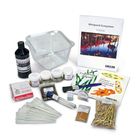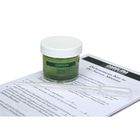Simulating Succession Ecosystems Activity
 Carolina Staff
Carolina Staff
Updated December 2018
We often view an ecosystem as a stable system in which populations of various organisms live in equilibrium—among themselves and with the abiotic environment. This view paints an incomplete picture because it overlooks the variable of time. Time was required to establish the apparent stability, and changes continue to occur over time. The gradual replacement of established species or shifts in proportions of species or populations is ecological succession. Succession is sometimes difficult for students to comprehend because of the complexity of an ecosystem and because succession often occurs through gradual change over several generations.
It is possible, though, to perform a hands-on experiment in the classroom to reinforce the concept of succession. Each of several student groups can set up a simple ecosystem and observe ecological succession in about 2 weeks. The simple design lends itself well to further experimentation and adjustment of variables. It encourages collaboration as groups compare their emerging communities and look for trends. Once the ecosystems are set up, they require little maintenance—just several minutes of observation every few days.
Next Generation Science Standards and 3-Dimensional Learning
This activity is appropriate for high school students and builds towards the following content standards for grades 9–12:
Disciplinary Core Idea: LS2: Ecosystems: Interactions, Energy, and Dynamics
Performance Expectations:
-
HS-LS2-1: Use mathematical and/or computational representations to support explanations of factors that affect carrying capacity of ecosystems at different scales.
-
HS-LS2-2: Use mathematical representations to support and revise explanations based on evidence about factors affecting biodiversity and populations in ecosystems of different scales.
Objective
Each student (or student group) will create a mini ecosystem and then observe and document the changes over time.
Materials
- Screw-Top Culture Vials/Tubes (1 per student or group)
- Wheat Grains
- Hay
- Plastic Pipets
- Sterile Soil
- Springwater
- Test Tube Rack
- Microscope(s)
- Slides and Coverslips
- Protozoan Mixture Culture
- Algae Survey Mixture Culture
- Alga-Gro® Freshwater Medium
Procedure
Setup
- Place a screw-top vial in a test tube rack to hold it upright.
- Add 1 wheat grain.
- Cut several small pieces of the hay and add it to your vial.
- Cover the bottom of the vial with a small amount of the sterile soil.
- Fill the vial about halfway with springwater.
- Add 1 pipet full of water from the protozoa culture container (or “pond” water).
- Add 1 pipet full of water from the algae culture container (or “pond” water).
- Add 10 drops of the Alga-Gro® medium to your vial and top it off with springwater.
- Loosely cap and then label your vial.
Observation
Place your vial in bright but indirect natural light or under a grow light. Make sure that the cap is in place loosely to allow for gas exchange. You may need to add springwater to the vial as the water evaporates. Over the next 2 weeks, changes will occur in the community within the vial.
Using a pipet, slide, and coverslip, survey the organisms in your vial every few days. Note any changes in the numbers of species as well as the population density of the different species. Also note any other changes, such as in color or odor. Have students identify the organisms as best they can and record their results. They can use our free illustrated key to common freshwater microorganisms.
Have groups compare their findings, either informally or through presentations. Together try to discern a pattern of succession in the ecosystems.
Extensions
- To alter or extend this activity, you might have groups maintain their vials under slightly different conditions (e.g., of light or temperature). For example, some groups could create a “disturbance” in their environment such as intentionally introducing a different species or a spoonful of extra soil (sudden sedimentation). Students can then compare how the change affected the rate or path of succession.
- You can also have students relate different stages of succession to examples they find around the school (e.g., a weed growing out of the pavement or between bricks is an example of a pioneer species, corresponding loosely with the organisms students observed initially in their vials).
Discussion questions
- What environmental factors impact the organisms in the vial?
- What organisms did you observe first? Over time, how did the populations change? What factors may have influenced these population changes?
- What impact do certain species appear to have on others in the vial?
- Identify examples of succession in the local environment. How might you model some of these types of succession in the classroom?
- What are some ways in which people influence succession in ecosystems?
*If you have a Carolina™ Minipond Ecosystem in your classroom, water samples from your classroom “pond” can substitute for the protozoan and algae cultures in the student ecosystem tubes.
For a more in-depth study you may like Carolina EcoKits®: Succession in a Hay Infusion

















